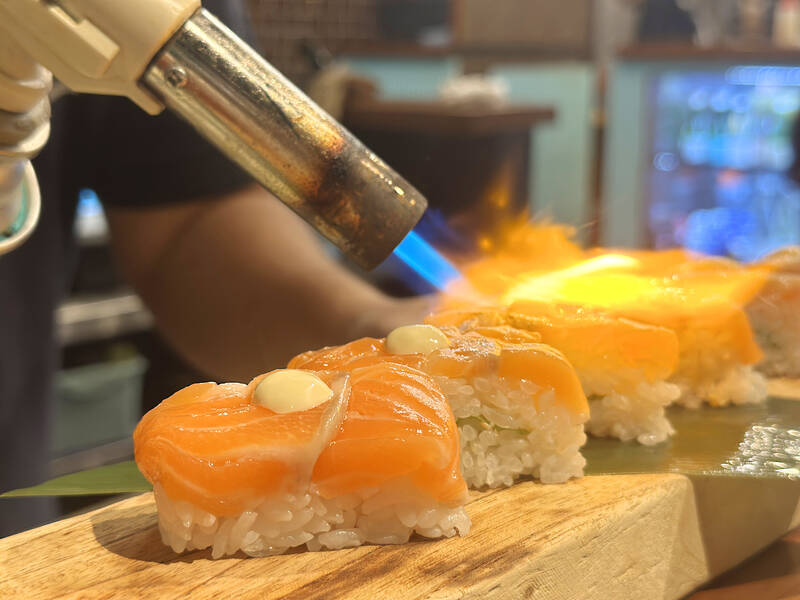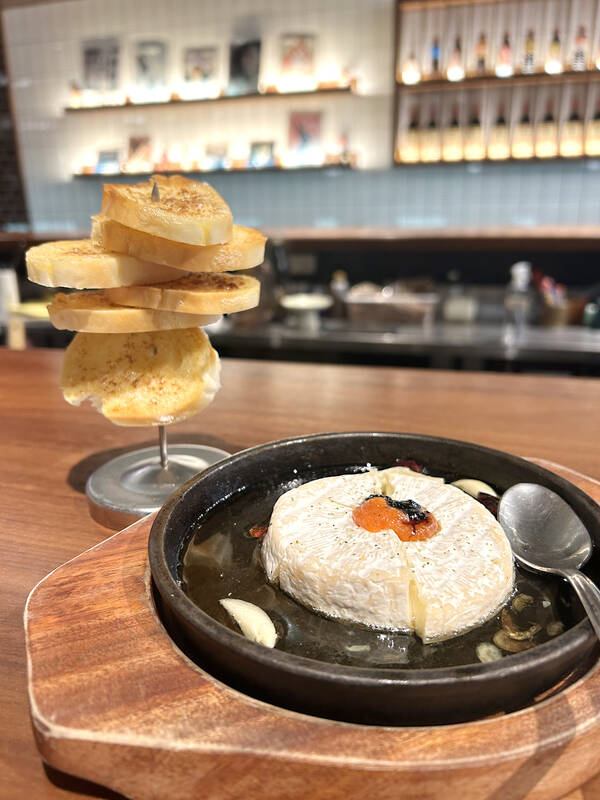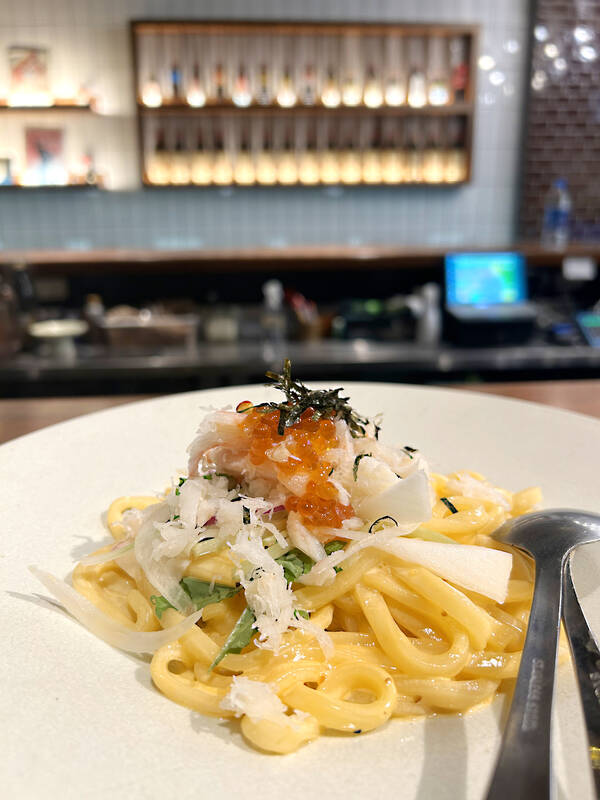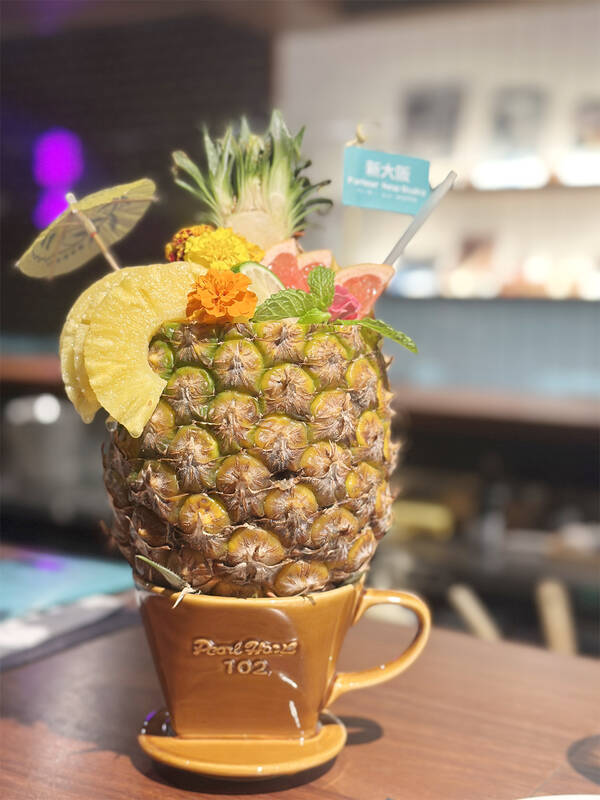Japanese is on the menu tonight. Yes, Taipei may be sprawling with cozy Izakayas and infamous ramen franchises, but for anyone in the market for authentic Japanese cuisine with both style and an inviting atmosphere, Parlor New Osaka offers a fresh, elevated take on our northeastern neighbor’s classics, its vibe nestled between cozy old-school class and swanky cocktail bar.
The walls are plastered with kitsch Japanese nostalgia; a retro pinball game, neon-lit signs and cutouts of Japanese pinup dolls. But up at the central wraparound bar, the space steers more sophisticated: bottles of whiskey and elegant glasses backlit with a warm orange glow, suited patrons and after-work dates sharing Japanese-style tapas over cocktails.
The menu offers the same dichotomy of homely retro and chic cuisine.

Photo: Hollie Younger
We find Osaka staples like Battera, pressed sushi, and kushikatsu, deep-fried skewers of anything the chef desires, served with a vat of inky dipping sauce. Then we have Japanese classics of udon Carbonaras and glistening sashimi. But what we came for are the clever little small plates, like the Camembert with spicy cod roe ajillo, and modern fusions like the New Osaka sangria (NT$280). Subtle nods to Spain with flawless Japanese execution.
The ever-changing menu du jour treats us to yet more indulgent offerings, from seared beef tongue to flounder fin sushi.
Arriving at our designated spot at the bar, I’m delighted to find a singular white-shelled egg decorated with a hand-drawn caricature and my name, a cheeky replacement for the oh-so-pedestrian “reserved” sign.

Photo: Hollie Younger
Opposite, the chef whips out a blowtorch — are these now in every Taipei bistro? — and chars the fleshy sashimi atop their signature Battera sushi, an Osaka invention of cuboidal rice pressed in bamboo molds, for which they swap the classic mackerel or seared salmon. The tone has been set.
A sucker for a gimmick, I spot a giant cocktail served in an entire hollowed-out pineapple and get to ordering. It’s for one, I’m reassured, as three helpings of my five-a-day arrive in a pineapple almost as large as my head.
This is the “pineapple tiki” variant of the New Osaka fruit punch (NT$500); if pineapple’s not your thing, rest assured they can also shove a liter of cocktail into the husk of a honeydew melon.

Photo: Hollie Younger
Despite the hoopla of the presentation, it’s actually a darned good cocktail, essentially a Pina Colada that’s heavy on the pina, and the abundance of fruit atop makes for a good palette cleanser throughout the sitting.
With the welcomed smell of buttery garlic bread wafting from my left, I do as any wise diner does and point unabashedly at the couple beside us with an “I’ll have that.” This is, of course, the aforementioned Camembert & spicy cod roe ajillo (NT$280) served with toasted garlic bread.
In a mini-Mediterranean-style cast iron pan, an oozy and overindulgent wheel of Camembert is bathed in butter, garlic and chili and topped with a spicy cod roe dressing. Clearly unafraid of over-the-top presentation, the garlic bread comes skewered in what looks like a spike for receipts.

Photo: Hollie Younger
Now, I didn’t think I’d recommend a Japanese restaurant for Camembert, but this is ridiculously good. Japanese cuisine loves butter as much as the next, and this is served with lashings; it’s gooey, and moreish and that mentaiko really gives it a little something-something.
The second must-order would be the Carbonara-inspired sea urchin “carbonala” udon (NT$430), reasonably priced for the generous helpings of luxury ingredients with uni, roe and sweet flaky crab meat piled atop. Italians look away, but it’s a creamy, fishy and all-round delightful Asian carbonara.
In the name of authenticity, we get the Chef’s choice of five kinds assorted kushikatsu (NT$200), which today is king oyster mushroom, squid, chicken, takoyaki — batter filled with grilled octopus — and tamagoyaki, or Japanese omelet. We dip in the Worcestershire-spiked soy sauce with satisfaction.
On the specials menu, we choose the grilled beef tongue with scallion sauce (NT$450), always a fine choice of protein. Just lightly grilled on the exterior, the slices remain juicy pink and medium rare, complimenting the zing of the scallions and a freshly squeezed lemon.
Luxury ingredients at reasonable prices, a space elegant yet welcoming and a menu that caters to both the authentic and the inventive — Parlor New Osaka’s whimsical presentations and impressive cocktail list cements it as a must-visit Japanese offering.

That US assistance was a model for Taiwan’s spectacular development success was early recognized by policymakers and analysts. In a report to the US Congress for the fiscal year 1962, former President John F. Kennedy noted Taiwan’s “rapid economic growth,” was “producing a substantial net gain in living.” Kennedy had a stake in Taiwan’s achievements and the US’ official development assistance (ODA) in general: In September 1961, his entreaty to make the 1960s a “decade of development,” and an accompanying proposal for dedicated legislation to this end, had been formalized by congressional passage of the Foreign Assistance Act. Two

Despite the intense sunshine, we were hardly breaking a sweat as we cruised along the flat, dedicated bike lane, well protected from the heat by a canopy of trees. The electric assist on the bikes likely made a difference, too. Far removed from the bustle and noise of the Taichung traffic, we admired the serene rural scenery, making our way over rivers, alongside rice paddies and through pear orchards. Our route for the day covered two bike paths that connect in Fengyuan District (豐原) and are best done together. The Hou-Feng Bike Path (后豐鐵馬道) runs southward from Houli District (后里) while the

March 31 to April 6 On May 13, 1950, National Taiwan University Hospital otolaryngologist Su You-peng (蘇友鵬) was summoned to the director’s office. He thought someone had complained about him practicing the violin at night, but when he entered the room, he knew something was terribly wrong. He saw several burly men who appeared to be government secret agents, and three other resident doctors: internist Hsu Chiang (許強), dermatologist Hu Pao-chen (胡寶珍) and ophthalmologist Hu Hsin-lin (胡鑫麟). They were handcuffed, herded onto two jeeps and taken to the Secrecy Bureau (保密局) for questioning. Su was still in his doctor’s robes at

Mirror mirror on the wall, what’s the fairest Disney live-action remake of them all? Wait, mirror. Hold on a second. Maybe choosing from the likes of Alice in Wonderland (2010), Mulan (2020) and The Lion King (2019) isn’t such a good idea. Mirror, on second thought, what’s on Netflix? Even the most devoted fans would have to acknowledge that these have not been the most illustrious illustrations of Disney magic. At their best (Pete’s Dragon? Cinderella?) they breathe life into old classics that could use a little updating. At their worst, well, blue Will Smith. Given the rapacious rate of remakes in modern